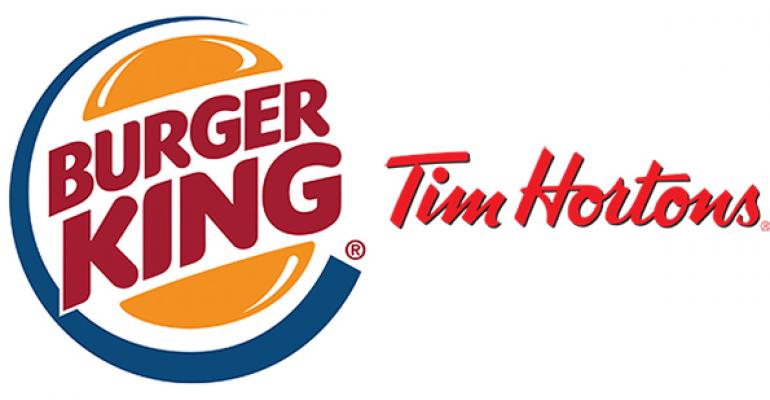 NRN editor and restaurant finance expert Jennings breaks down what you should be watching in the industry this week. Connect with her on the latest finance trends and news at @livetodineout and [email protected].
NRN editor and restaurant finance expert Jennings breaks down what you should be watching in the industry this week. Connect with her on the latest finance trends and news at @livetodineout and [email protected].
It’s not about paying less in the way of taxes. It’s about growth.
That’s what Burger King Worldwide Inc. and Tim Hortons Inc. officials insisted Tuesday after confirming the planned marriage of their two brands.
The $11.4 billion merger will create the world’s third-largest quick-service company, following Oak Brook, Ill.-based McDonald’s, at No. 1, and Louisville, Ky.-based Yum! Brands Inc., at No. 2.
Though Burger King will remain headquartered in Miami and Tim Hortons will remain based in Oakville, Ontario, the proposed global parent will be based in Canada.
The reason: Canada will likely be the merged company’s largest market in terms of market share, revenue, assets and employees, Burger King executive chairman Alex Behring said.
However, some observers see the move as an attempt at a tax inversion. One U.S. Senator even called for a boycott of Burger King, amid accusations of abandoning the U.S. Negative comments also flooded the burger chain’s Facebook page.
Daniel Schwartz, who will be group chief executive of the new company, said Burger King will continue to pay federal, state and city taxes in the U.S., as it has since the chain was founded in 1954.
Burger King’s tax rate will not change in any meaningful way, and will not be significantly different from that of Tim Hortons, he said.
Citing Burger King’s annual report, the Los Angeles Times noted that the chain’s overall effective tax rate in 2013 was 27.5 percent, while Tim Hortons’ rate that year was 26.8 percent.
“This is not a tax-driven deal,” added Behring. “This is fundamentally about growth.”
The appeal for Burger King parent 3G, the Brazilian private-equity firm who will hold a majority stake in the merged company, is primarily the opportunity to grow Canada’s beloved Tim Hortons brand around the globe, officials said.
Marc Caira, Tim Hortons’ president and chief executive, described Burger King and backer 3G Capital as “young, aggressive, active partners” who offer infrastructure support that will accelerate Tim Hortons’ growth internationally, but particularly in the U.S.
Caira may have used the term “young” literally. Schwartz is only 34 years old, and several other executives with the burger chain are under 30 years old.
“All the elements are there, and we are very, very confident that we can grow much quicker in this must-win market of the U.S. than we could on our own,” said Caira. “We have admired the strides Burger King has made. We can learn from that experience.”
Tim Hortons has attempted similar partnerships in the past. In 1995, it was acquired by Wendy’s International Inc., a merger designed to further the brand’s growth in the U.S.
Over the next decade, the chain grew in the Northeast and Midwest, but Wendy’s activist investors later pressed the burger operator to divest. In 2006, Tim Hortons completed an initial public offering and was spun off as a separate company.
Unlike with Wendy’s, co-branding or cross-pollination of menus is not in the plans for the Burger King/Tim Hortons marriage, both companies said.
With McDonald’s struggling to turn around same-store sales declines, industry observers speculate that the fast-food giant has lost its appeal to Millennials.
For Burger King, the move to grow Tim Hortons in the U.S. offers a potential hook for those Millennials, who love coffee and breakfast sandwiches.
What the deal means for growth
(Continued from page 1)
Kevin Burke, managing director of Los Angeles-based Trinity Capital LLC, saw the merger as a good move by Burger King.
“This will give them a concept that could get into rapid growth mode,” said Burke. “You have to continue to deliver on growth.”
With domestic Burger King locations facing continued margin challenges post-recession, the pace of the burger chain’s planned remodeling has been held back.
“It is going to be hard for Burger King to show meaningful domestic growth,” he said.
For the first half of 2014, Burger King’s global unit count grew more than 5 percent, or by 682 locations, to more than 13,808 units, compared with the first half of 2013. Units in the U.S. and Canada shrunk slightly, however, decreasing by 46 restaurants, to 7,371 locations.
With a larger market cap, the merged companies would likely attract larger investors and more analyst coverage, and it will close the gap with larger companies like Yum! Brands, Burke added.
Growing Tim Hortons in the U.S., however, will be a challenge, with powerful competitors like Dunkin’ Brands Group Inc. expanding its coffee-focused Dunkin’ Donuts chain to the West. The Canton, Mass.-based chain includes about 7,000 units in the U.S., and plans to double in size to 15,000 locations over the next two decades.
Seattle-based Starbucks Corp., with more than 20,000 units globally and about 6,800 in the U.S., is also accelerating growth, with 650 new locations planned in the Americas region this year.
Nearly 6,000-unit Taco Bell also recently joined the quick-service breakfast wars, pledging to unseat — or at least unsettle — McDonald’s as the breakfast category leader.
In its June 29-ended second quarter, Tim Hortons said breakfast sales in the U.S. contributed to a 5.9-percent increase in same-store sales there, though the increase was largely the result of hikes in average check and pricing. Tim Hortons’ same-store sales rose 2.6 percent in Canada.
Net income was flat for the quarter, at about $123.8 million Canadian. Revenue rose 9.3 percent, to $874.3 million Canadian.
Contact Lisa Jennings at [email protected].
Follow her on Twitter: @livetodineout





